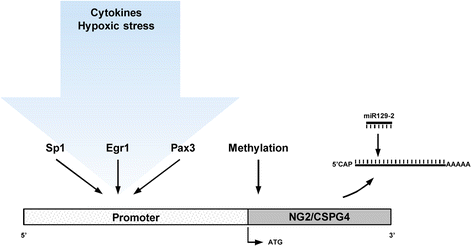The regulatory mechanisms of NG2/CSPG4 expression
- PMID: 28536635
- PMCID: PMC5415841
- DOI: 10.1186/s11658-017-0035-3
The regulatory mechanisms of NG2/CSPG4 expression
Abstract
Neuron-glial antigen 2 (NG2), also known as chondroitin sulphate proteoglycan 4 (CSPG4), is a surface type I transmembrane core proteoglycan that is crucially involved in cell survival, migration and angiogenesis. NG2 is frequently used as a marker for the identification and characterization of certain cell types, but little is known about the mechanisms regulating its expression. In this review, we provide evidence that the regulation of NG2 expression underlies inflammation and hypoxia and is mediated by methyltransferases, transcription factors, including Sp1, paired box (Pax) 3 and Egr-1, and the microRNA miR129-2. These regulatory factors crucially determine NG2-mediated cellular processes such as glial scar formation in the central nervous system (CNS) or tumor growth and metastasis. Therefore, they are potential targets for the establishment of novel NG2-based therapeutic strategies in the treatment of CNS injuries, cancer and other conditions of these types.
Keywords: CSPG4; Hypoxia; Inflammation; Methylation; MiRNA; NG2; Transcription.
Figures
Similar articles
-
NG2 expression in NG2 glia is regulated by binding of SoxE and bHLH transcription factors to a Cspg4 intronic enhancer.Glia. 2018 Dec;66(12):2684-2699. doi: 10.1002/glia.23521. Epub 2018 Oct 10. Glia. 2018. PMID: 30306660 Free PMC article.
-
Effects of chondroitin sulfate proteoglycan 4 (NG2/CSPG4) on soft-tissue sarcoma growth depend on tumor developmental stage.J Biol Chem. 2018 Feb 16;293(7):2466-2475. doi: 10.1074/jbc.M117.805051. Epub 2017 Dec 1. J Biol Chem. 2018. PMID: 29196603 Free PMC article.
-
NG2/CSPG4 and progranulin in the posttraumatic glial scar.Matrix Biol. 2018 Aug;68-69:571-588. doi: 10.1016/j.matbio.2017.10.002. Epub 2017 Oct 17. Matrix Biol. 2018. PMID: 29054751 Review.
-
The Significance of Chondroitin Sulfate Proteoglycan 4 (CSPG4) in Human Gliomas.Int J Mol Sci. 2018 Sep 12;19(9):2724. doi: 10.3390/ijms19092724. Int J Mol Sci. 2018. PMID: 30213051 Free PMC article. Review.
-
Chondroitin Sulphate Proteoglycan 4 (NG2/CSPG4) Localization in Low- and High-Grade Gliomas.Cells. 2020 Jun 24;9(6):1538. doi: 10.3390/cells9061538. Cells. 2020. PMID: 32599896 Free PMC article.
Cited by
-
Chondroitin Sulfate Proteoglycan 4 Provides New Treatment Approach to Preventing Peritoneal Dissemination in Ovarian Cancer.Int J Mol Sci. 2024 Jan 28;25(3):1626. doi: 10.3390/ijms25031626. Int J Mol Sci. 2024. PMID: 38338902 Free PMC article.
-
Basement-Membrane-Related Gene Signature Predicts Prognosis in WHO Grade II/III Gliomas.Genes (Basel). 2022 Oct 7;13(10):1810. doi: 10.3390/genes13101810. Genes (Basel). 2022. PMID: 36292695 Free PMC article.
-
Clinical-Scale Production of CAR-T Cells for the Treatment of Melanoma Patients by mRNA Transfection of a CSPG4-Specific CAR under Full GMP Compliance.Cancers (Basel). 2019 Aug 16;11(8):1198. doi: 10.3390/cancers11081198. Cancers (Basel). 2019. PMID: 31426437 Free PMC article.
-
Transcriptional and metabolic effects of aspartate-glutamate carrier isoform 1 (AGC1) downregulation in mouse oligodendrocyte precursor cells (OPCs).Cell Mol Biol Lett. 2024 Mar 29;29(1):44. doi: 10.1186/s11658-024-00563-z. Cell Mol Biol Lett. 2024. PMID: 38553684 Free PMC article.
-
Identification of key molecular biomarkers involved in reactive and neurodegenerative processes present in inherited congenital hydrocephalus.Fluids Barriers CNS. 2021 Jul 2;18(1):30. doi: 10.1186/s12987-021-00263-2. Fluids Barriers CNS. 2021. PMID: 34215285 Free PMC article.
References
Publication types
MeSH terms
Substances
LinkOut - more resources
Full Text Sources
Other Literature Sources


